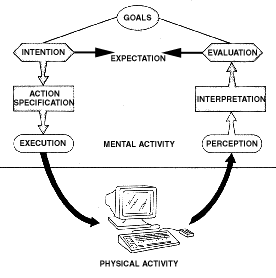Cognitive Science
Writers and interface designers both seek to support the needs, tasks, and goals of their audience. When the reader of a document is also the user of a computer system, it is important to remember that the user's psychological goals will be translated into physical actions. Cognitive scientist Donald Norman seeks to help interface designers support users' perception, cognition, and motor functions by suggesting the following "Seven Stages of User Activities."

(
Norman 1986
)
Norman describes the problem writers and designers face in meeting the goals of users as two gulfs between the user and the system. The Gulf of Execution represents the difficulty the user has in translating a psychological goal into a physical action. For example, the goal "learn more about avocados" is purely psychological. The user of a hypertext system on the WWW will need to see the available links, recognize the appropriate choice, and use the mouse to point and click on that link. Thus, in order to learn more about avocados, the user needs to execute a set of physical steps.
The Gulf of Evaluation represents the user's difficulty in evaluating whether the response of the computer system meets the desired goal. In the above example, the user would need to perceive the system response, examine the resulting node, and assess whether it presented the proper information about avocados. In the same way that the user needed to translate a psychological goal into a physical action sequence to bridge the Gulf of Execution, the user needs to compare the physical response of the system against the psychological goal to bridge the Gulf of Evaluation.
An awareness that the reader of a document on the WWW is also the user of a computer system can make writers more aware of the perceptual, cognitive, and physical activities that users must engage in to meet their goals. The field of Interface Design can provide advice to writers on selecting colors, icons, and graphics which will support users' navigation and minimize cognitive load. The field of Human- Computer Interaction can help writers focus on the usability of their system in addition to the readability of their text.
